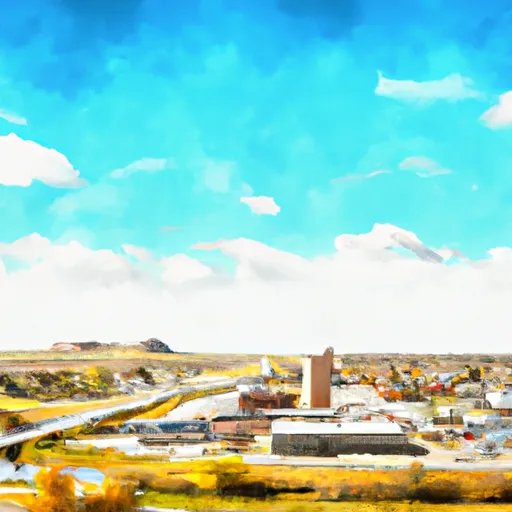-
 Snoflo Premium
Snoflo Premium
Get unlimited access to all our content
With no Ad interruptions! - Start Your Free Trial Login with existing account
Rock-River
Eden Index
Climate
6.5
•
Recreation
•
Community
3.0
•
Safeguard
3.3/10

Rock River is a small town located in Albany County, Wyoming. It is situated at an elevation of 7,000 feet above sea level and has a population of approximately 250 people. The climate in Rock River is characterized by cold winters and mild summers. The average temperature in the winter months ranges from 10°F to 30°F, while summer temperatures typically range from 60°F to 80°F. Precipitation is relatively low, with an average annual rainfall of around 12 inches.
The town is surrounded by natural beauty, with the Laramie Mountains and the Medicine Bow National Forest in close proximity. The area boasts several outdoor recreation opportunities, including hiking, camping, and fishing. The Laramie River, which flows near Rock River, offers excellent fishing opportunities for trout enthusiasts. Additionally, there are numerous trails in the nearby national forest that cater to hikers and mountain bikers, providing stunning views of the surrounding landscapes.
Overall, Rock River offers a picturesque setting for outdoor enthusiasts to enjoy a variety of recreational activities while experiencing the diverse climate and hydrology of the region.
What is the Eden Index?
The Snoflo Eden Index serves as a comprehensive rating system for regions, evaluating their desirability through a holistic assessment of climate health, outdoor recreation opportunities, and natural disaster risk, acknowledging the profound impact of these factors on livability and well-being.
Climate Health Indicator (CHI): 6.5
Rock-River receives approximately
313mm of rain per year,
with humidity levels near 68%
and air temperatures averaging around
6°C.
Rock-River has a plant hardyness factor of
4, meaning
plants and agriculture in this region thrive during a short period during spring and early summer. Most
plants will die off during the colder winter months.
By considering the ideal temperature range, reliable water supplies, clean air, and stable seasonal rain or snowpacks, the Climate Health Indicator (CHI) underscores the significance of a healthy climate as the foundation for quality living.
A healthy climate is paramount for ensuring a high quality of life and livability in a region, fostering both physical well-being and environmental harmony. This can be characterized by ideal temperatures, reliable access to water supplies, clean air, and consistent seasonal rain or snowpacks.
Weather Forecast
Streamflow Conditions
North Platte
Area Rivers
North Platte
Snowpack Depths
North Platte
Reservoir Storage Capacity
North Platte
Groundwater Levels
Recreational Opportunity Index (ROI):
The Recreational Opportunity Index (ROI) recognizes the value of outdoor recreational options, such as parks, hiking trails, camping sites, and fishing spots, while acknowledging that climate plays a pivotal role in ensuring the comfort and consistency of these experiences.
Access to outdoor recreational opportunities, encompassing activities such as parks, hiking, camping, and fishing, is crucial for overall well-being, and the climate plays a pivotal role in enabling and enhancing these experiences, ensuring that individuals can engage in nature-based activities comfortably and consistently.
Camping Areas
| Campground | Campsites | Reservations | Toilets | Showers | Elevation |
|---|---|---|---|---|---|
| Libby Creek | 65 | 8,626 ft | |||
| Campbell Creek | 6 | 7,954 ft | |||
| North Fork | 60 | 9,212 ft | |||
| Miller Lake | 7 | 9,052 ft | |||
| Meeboer Lake Access Area - WGF | None | 7,239 ft | |||
| Twin Buttes Reservoir Public Access - WGF | None | 7,258 ft | |||
| Lake Owen | 35 | 8,972 ft | |||
| Lake Hattie Public Access Area - WGF | None | 7,277 ft | |||
| Evans Creek | 10 | 9,048 ft |
Nearby Ski Areas
Catastrophe Safeguard Index (CSI):
The Catastrophe Safeguard Index (CSI) recognizes that natural disaster risk, encompassing floods, fires, hurricanes, and tornadoes, can drastically affect safety and the overall appeal of an area.
The level of natural disaster risk in a region significantly affects safety and the overall livability, with climate change amplifying these risks by potentially increasing the frequency and intensity of events like floods, fires, hurricanes, and tornadoes, thereby posing substantial challenges to community resilience and well-being.
Community Resilience Indicator (CRI): 3.0
The Community Resilience Indicator (CRI) recognizes that education, healthcare, and socioeconomics are crucial to the well-being of a region. The CRI acknowledges the profound impact of these elements on residents' overall quality of life. By evaluating educational resources, healthcare accessibility, and economic inclusivity, the index captures the essential aspects that contribute to a thriving community, fostering resident satisfaction, equity, and social cohesion.

